Analyzing Syrian Refugee Crisis
VerifiedAdded on 2023/03/30
|12
|3282
|103
AI Summary
This essay analyzes the Syrian refugee crisis, including the causes, human rights violations, and health issues faced by the refugees. It also discusses the international laws and policies related to refugees.
Contribute Materials
Your contribution can guide someone’s learning journey. Share your
documents today.

ANALYSING SYRIAN REFUGEE CRISIS
Analyzing Syrian Refugee Crisis
Name of Student
Name of University
Author Note
Analyzing Syrian Refugee Crisis
Name of Student
Name of University
Author Note
Secure Best Marks with AI Grader
Need help grading? Try our AI Grader for instant feedback on your assignments.
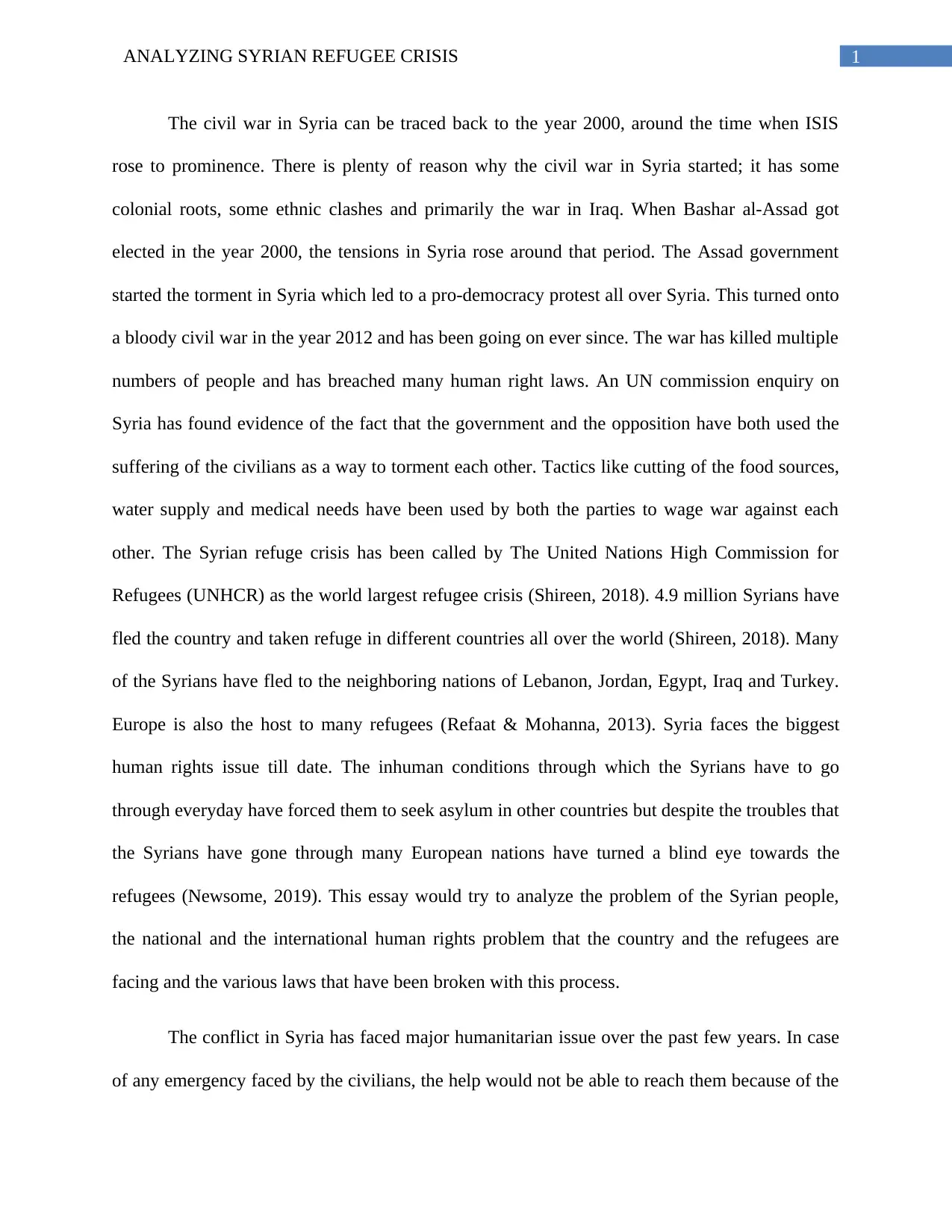
1ANALYZING SYRIAN REFUGEE CRISIS
The civil war in Syria can be traced back to the year 2000, around the time when ISIS
rose to prominence. There is plenty of reason why the civil war in Syria started; it has some
colonial roots, some ethnic clashes and primarily the war in Iraq. When Bashar al-Assad got
elected in the year 2000, the tensions in Syria rose around that period. The Assad government
started the torment in Syria which led to a pro-democracy protest all over Syria. This turned onto
a bloody civil war in the year 2012 and has been going on ever since. The war has killed multiple
numbers of people and has breached many human right laws. An UN commission enquiry on
Syria has found evidence of the fact that the government and the opposition have both used the
suffering of the civilians as a way to torment each other. Tactics like cutting of the food sources,
water supply and medical needs have been used by both the parties to wage war against each
other. The Syrian refuge crisis has been called by The United Nations High Commission for
Refugees (UNHCR) as the world largest refugee crisis (Shireen, 2018). 4.9 million Syrians have
fled the country and taken refuge in different countries all over the world (Shireen, 2018). Many
of the Syrians have fled to the neighboring nations of Lebanon, Jordan, Egypt, Iraq and Turkey.
Europe is also the host to many refugees (Refaat & Mohanna, 2013). Syria faces the biggest
human rights issue till date. The inhuman conditions through which the Syrians have to go
through everyday have forced them to seek asylum in other countries but despite the troubles that
the Syrians have gone through many European nations have turned a blind eye towards the
refugees (Newsome, 2019). This essay would try to analyze the problem of the Syrian people,
the national and the international human rights problem that the country and the refugees are
facing and the various laws that have been broken with this process.
The conflict in Syria has faced major humanitarian issue over the past few years. In case
of any emergency faced by the civilians, the help would not be able to reach them because of the
The civil war in Syria can be traced back to the year 2000, around the time when ISIS
rose to prominence. There is plenty of reason why the civil war in Syria started; it has some
colonial roots, some ethnic clashes and primarily the war in Iraq. When Bashar al-Assad got
elected in the year 2000, the tensions in Syria rose around that period. The Assad government
started the torment in Syria which led to a pro-democracy protest all over Syria. This turned onto
a bloody civil war in the year 2012 and has been going on ever since. The war has killed multiple
numbers of people and has breached many human right laws. An UN commission enquiry on
Syria has found evidence of the fact that the government and the opposition have both used the
suffering of the civilians as a way to torment each other. Tactics like cutting of the food sources,
water supply and medical needs have been used by both the parties to wage war against each
other. The Syrian refuge crisis has been called by The United Nations High Commission for
Refugees (UNHCR) as the world largest refugee crisis (Shireen, 2018). 4.9 million Syrians have
fled the country and taken refuge in different countries all over the world (Shireen, 2018). Many
of the Syrians have fled to the neighboring nations of Lebanon, Jordan, Egypt, Iraq and Turkey.
Europe is also the host to many refugees (Refaat & Mohanna, 2013). Syria faces the biggest
human rights issue till date. The inhuman conditions through which the Syrians have to go
through everyday have forced them to seek asylum in other countries but despite the troubles that
the Syrians have gone through many European nations have turned a blind eye towards the
refugees (Newsome, 2019). This essay would try to analyze the problem of the Syrian people,
the national and the international human rights problem that the country and the refugees are
facing and the various laws that have been broken with this process.
The conflict in Syria has faced major humanitarian issue over the past few years. In case
of any emergency faced by the civilians, the help would not be able to reach them because of the
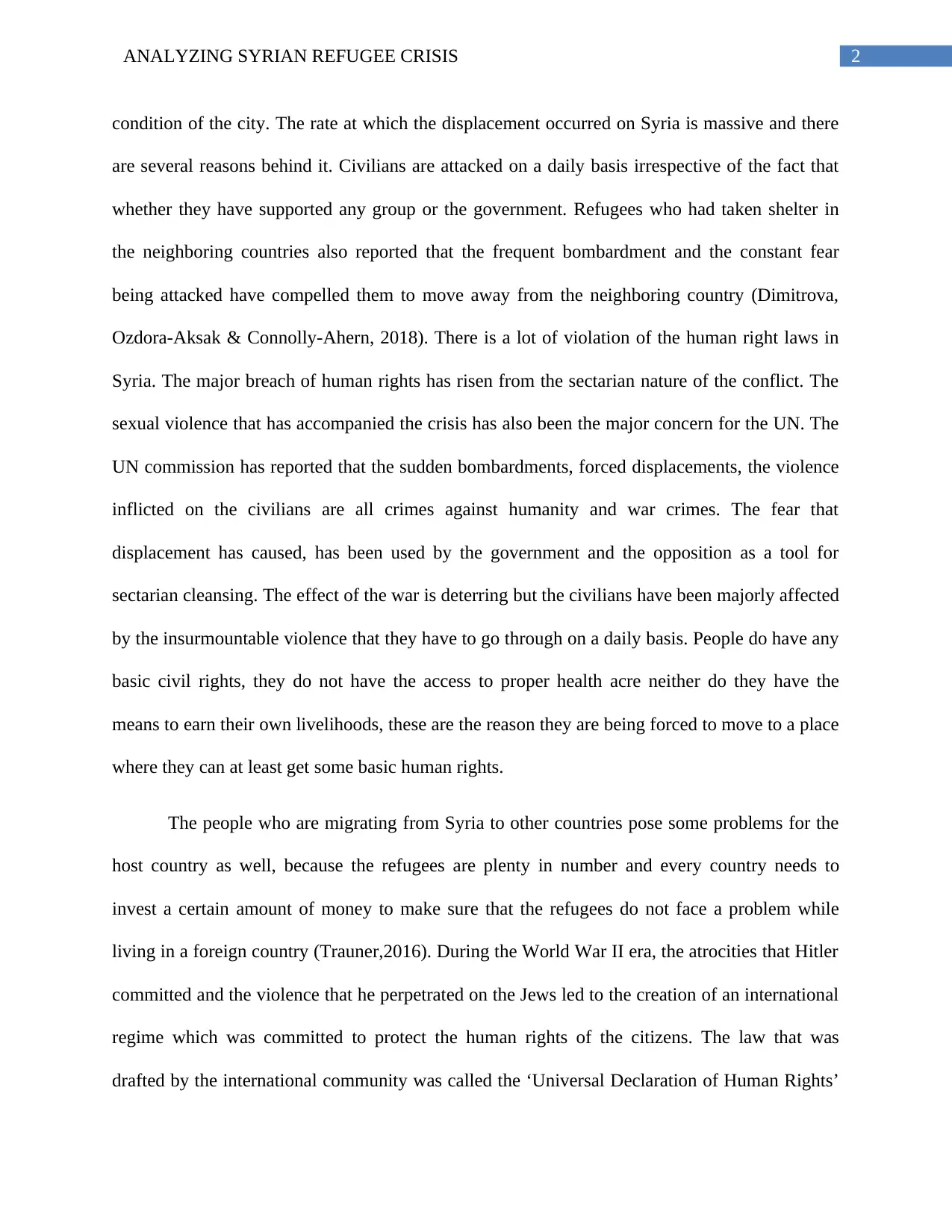
2ANALYZING SYRIAN REFUGEE CRISIS
condition of the city. The rate at which the displacement occurred on Syria is massive and there
are several reasons behind it. Civilians are attacked on a daily basis irrespective of the fact that
whether they have supported any group or the government. Refugees who had taken shelter in
the neighboring countries also reported that the frequent bombardment and the constant fear
being attacked have compelled them to move away from the neighboring country (Dimitrova,
Ozdora-Aksak & Connolly-Ahern, 2018). There is a lot of violation of the human right laws in
Syria. The major breach of human rights has risen from the sectarian nature of the conflict. The
sexual violence that has accompanied the crisis has also been the major concern for the UN. The
UN commission has reported that the sudden bombardments, forced displacements, the violence
inflicted on the civilians are all crimes against humanity and war crimes. The fear that
displacement has caused, has been used by the government and the opposition as a tool for
sectarian cleansing. The effect of the war is deterring but the civilians have been majorly affected
by the insurmountable violence that they have to go through on a daily basis. People do have any
basic civil rights, they do not have the access to proper health acre neither do they have the
means to earn their own livelihoods, these are the reason they are being forced to move to a place
where they can at least get some basic human rights.
The people who are migrating from Syria to other countries pose some problems for the
host country as well, because the refugees are plenty in number and every country needs to
invest a certain amount of money to make sure that the refugees do not face a problem while
living in a foreign country (Trauner,2016). During the World War II era, the atrocities that Hitler
committed and the violence that he perpetrated on the Jews led to the creation of an international
regime which was committed to protect the human rights of the citizens. The law that was
drafted by the international community was called the ‘Universal Declaration of Human Rights’
condition of the city. The rate at which the displacement occurred on Syria is massive and there
are several reasons behind it. Civilians are attacked on a daily basis irrespective of the fact that
whether they have supported any group or the government. Refugees who had taken shelter in
the neighboring countries also reported that the frequent bombardment and the constant fear
being attacked have compelled them to move away from the neighboring country (Dimitrova,
Ozdora-Aksak & Connolly-Ahern, 2018). There is a lot of violation of the human right laws in
Syria. The major breach of human rights has risen from the sectarian nature of the conflict. The
sexual violence that has accompanied the crisis has also been the major concern for the UN. The
UN commission has reported that the sudden bombardments, forced displacements, the violence
inflicted on the civilians are all crimes against humanity and war crimes. The fear that
displacement has caused, has been used by the government and the opposition as a tool for
sectarian cleansing. The effect of the war is deterring but the civilians have been majorly affected
by the insurmountable violence that they have to go through on a daily basis. People do have any
basic civil rights, they do not have the access to proper health acre neither do they have the
means to earn their own livelihoods, these are the reason they are being forced to move to a place
where they can at least get some basic human rights.
The people who are migrating from Syria to other countries pose some problems for the
host country as well, because the refugees are plenty in number and every country needs to
invest a certain amount of money to make sure that the refugees do not face a problem while
living in a foreign country (Trauner,2016). During the World War II era, the atrocities that Hitler
committed and the violence that he perpetrated on the Jews led to the creation of an international
regime which was committed to protect the human rights of the citizens. The law that was
drafted by the international community was called the ‘Universal Declaration of Human Rights’
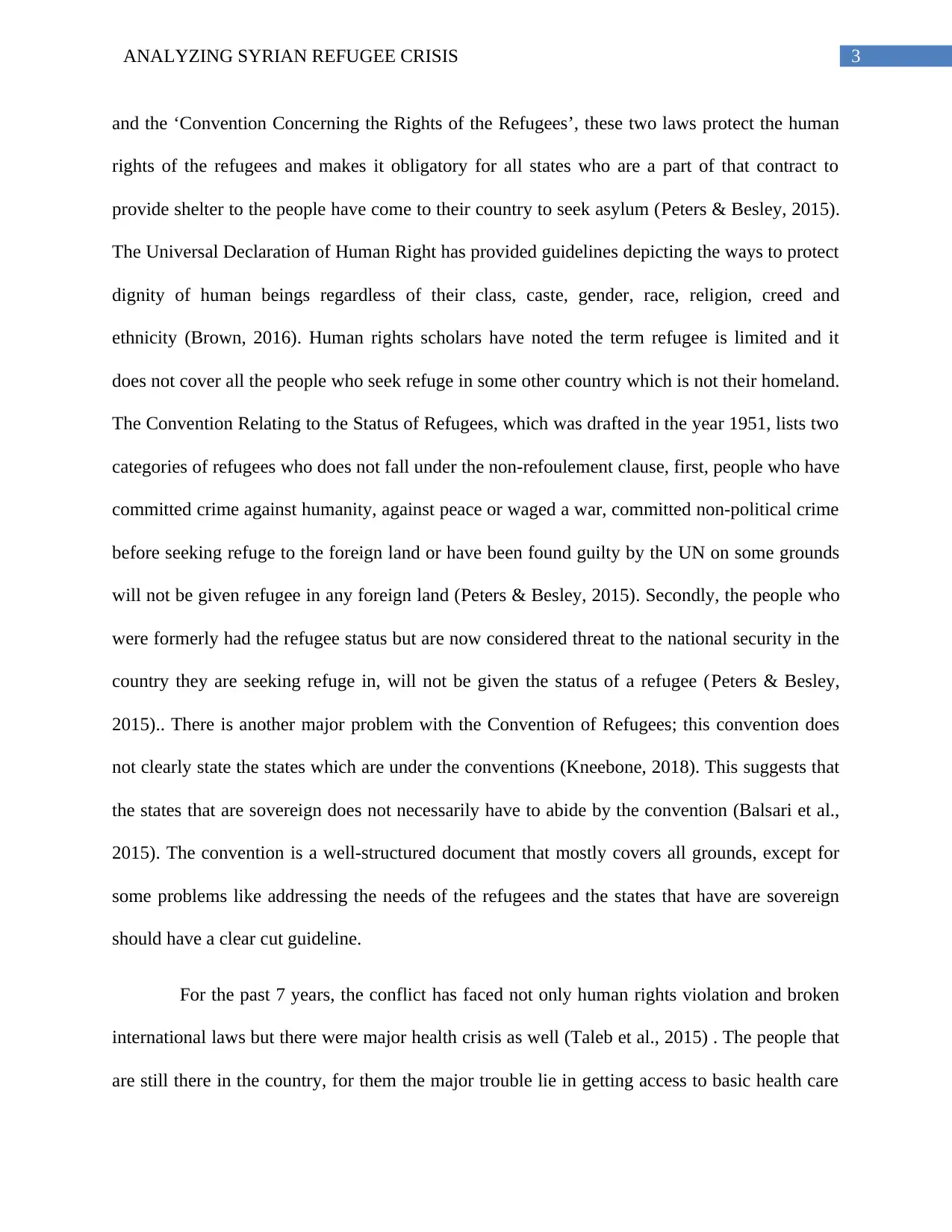
3ANALYZING SYRIAN REFUGEE CRISIS
and the ‘Convention Concerning the Rights of the Refugees’, these two laws protect the human
rights of the refugees and makes it obligatory for all states who are a part of that contract to
provide shelter to the people have come to their country to seek asylum (Peters & Besley, 2015).
The Universal Declaration of Human Right has provided guidelines depicting the ways to protect
dignity of human beings regardless of their class, caste, gender, race, religion, creed and
ethnicity (Brown, 2016). Human rights scholars have noted the term refugee is limited and it
does not cover all the people who seek refuge in some other country which is not their homeland.
The Convention Relating to the Status of Refugees, which was drafted in the year 1951, lists two
categories of refugees who does not fall under the non-refoulement clause, first, people who have
committed crime against humanity, against peace or waged a war, committed non-political crime
before seeking refuge to the foreign land or have been found guilty by the UN on some grounds
will not be given refugee in any foreign land (Peters & Besley, 2015). Secondly, the people who
were formerly had the refugee status but are now considered threat to the national security in the
country they are seeking refuge in, will not be given the status of a refugee (Peters & Besley,
2015).. There is another major problem with the Convention of Refugees; this convention does
not clearly state the states which are under the conventions (Kneebone, 2018). This suggests that
the states that are sovereign does not necessarily have to abide by the convention (Balsari et al.,
2015). The convention is a well-structured document that mostly covers all grounds, except for
some problems like addressing the needs of the refugees and the states that have are sovereign
should have a clear cut guideline.
For the past 7 years, the conflict has faced not only human rights violation and broken
international laws but there were major health crisis as well (Taleb et al., 2015) . The people that
are still there in the country, for them the major trouble lie in getting access to basic health care
and the ‘Convention Concerning the Rights of the Refugees’, these two laws protect the human
rights of the refugees and makes it obligatory for all states who are a part of that contract to
provide shelter to the people have come to their country to seek asylum (Peters & Besley, 2015).
The Universal Declaration of Human Right has provided guidelines depicting the ways to protect
dignity of human beings regardless of their class, caste, gender, race, religion, creed and
ethnicity (Brown, 2016). Human rights scholars have noted the term refugee is limited and it
does not cover all the people who seek refuge in some other country which is not their homeland.
The Convention Relating to the Status of Refugees, which was drafted in the year 1951, lists two
categories of refugees who does not fall under the non-refoulement clause, first, people who have
committed crime against humanity, against peace or waged a war, committed non-political crime
before seeking refuge to the foreign land or have been found guilty by the UN on some grounds
will not be given refugee in any foreign land (Peters & Besley, 2015). Secondly, the people who
were formerly had the refugee status but are now considered threat to the national security in the
country they are seeking refuge in, will not be given the status of a refugee (Peters & Besley,
2015).. There is another major problem with the Convention of Refugees; this convention does
not clearly state the states which are under the conventions (Kneebone, 2018). This suggests that
the states that are sovereign does not necessarily have to abide by the convention (Balsari et al.,
2015). The convention is a well-structured document that mostly covers all grounds, except for
some problems like addressing the needs of the refugees and the states that have are sovereign
should have a clear cut guideline.
For the past 7 years, the conflict has faced not only human rights violation and broken
international laws but there were major health crisis as well (Taleb et al., 2015) . The people that
are still there in the country, for them the major trouble lie in getting access to basic health care
Secure Best Marks with AI Grader
Need help grading? Try our AI Grader for instant feedback on your assignments.

4ANALYZING SYRIAN REFUGEE CRISIS
(Arnold, 2015). The most vulnerable area is the maternal and child health. There are plenty of
organizations and groups that are working in that war zone to make sure that the civilians get the
health care that they deserve. The women and children in Syria need immediate care and
attention. In this scenario, this research will describe the case of the ‘Brotherhood Medical
Center’, a clinic initially set up by local donors, now it has partnered with the Syrian expatriate
medical association to provide healthcare facilities to the mother and the child (Aburas et al.,
2018). At report by the United Nations population Fund (UNFPA) stated that 360,000 women
got pregnant in the year 2016 but they did not receive any pre or post-partum care (Aburas et al.,
2018). Similarly, in the case of children, because of the war there are problems in accessing food
because of which most of the children in Syria are suffering from malnutrition and on top of that
they do not have the means to access to basic healthcare, this presents as a big challenge
(Debkumar et al., 2015).In the year 2014, ‘Brotherhood Medical Care Center’ started to operate.
The medical center was formed by Syrian and Saudi physicians and donors, who wanted to build
to something to solve the medical crisis of the country (Aburas et al., 2018). They set up their
clinic in the Atimah village, where there is a Syrian displacement camp. The center took
approximately one year to get built. The center does not involve the participation of the
government, or any NGO. The main focus of the center was to take care of the women and
children and give pre-partum care. In its beginning days, the services of the clinic included
outpatient, gynecology and obstetrics and a pediatric clinic. The staff was limited to three
doctors, a nurse, a midwife, a housekeeper and an administrative aid. The members at the clinic
have increased over the years and also the services at the clinic have also increased. The clinic
has a dental wing that was opened recently. The center provides medical care to any person who
seek help at the clinic and they do it free of cost. The team at the center has faced major issues
(Arnold, 2015). The most vulnerable area is the maternal and child health. There are plenty of
organizations and groups that are working in that war zone to make sure that the civilians get the
health care that they deserve. The women and children in Syria need immediate care and
attention. In this scenario, this research will describe the case of the ‘Brotherhood Medical
Center’, a clinic initially set up by local donors, now it has partnered with the Syrian expatriate
medical association to provide healthcare facilities to the mother and the child (Aburas et al.,
2018). At report by the United Nations population Fund (UNFPA) stated that 360,000 women
got pregnant in the year 2016 but they did not receive any pre or post-partum care (Aburas et al.,
2018). Similarly, in the case of children, because of the war there are problems in accessing food
because of which most of the children in Syria are suffering from malnutrition and on top of that
they do not have the means to access to basic healthcare, this presents as a big challenge
(Debkumar et al., 2015).In the year 2014, ‘Brotherhood Medical Care Center’ started to operate.
The medical center was formed by Syrian and Saudi physicians and donors, who wanted to build
to something to solve the medical crisis of the country (Aburas et al., 2018). They set up their
clinic in the Atimah village, where there is a Syrian displacement camp. The center took
approximately one year to get built. The center does not involve the participation of the
government, or any NGO. The main focus of the center was to take care of the women and
children and give pre-partum care. In its beginning days, the services of the clinic included
outpatient, gynecology and obstetrics and a pediatric clinic. The staff was limited to three
doctors, a nurse, a midwife, a housekeeper and an administrative aid. The members at the clinic
have increased over the years and also the services at the clinic have also increased. The clinic
has a dental wing that was opened recently. The center provides medical care to any person who
seek help at the clinic and they do it free of cost. The team at the center has faced major issues
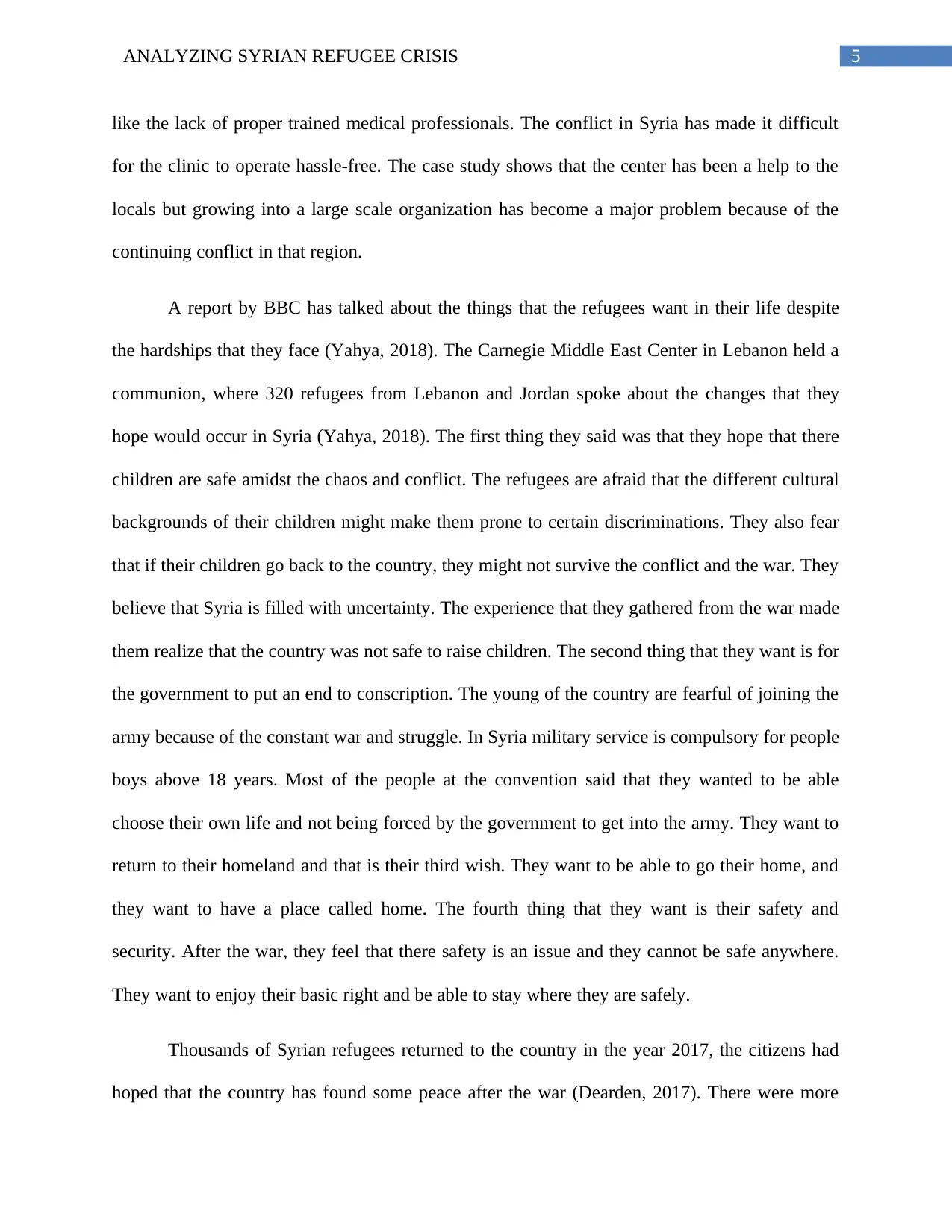
5ANALYZING SYRIAN REFUGEE CRISIS
like the lack of proper trained medical professionals. The conflict in Syria has made it difficult
for the clinic to operate hassle-free. The case study shows that the center has been a help to the
locals but growing into a large scale organization has become a major problem because of the
continuing conflict in that region.
A report by BBC has talked about the things that the refugees want in their life despite
the hardships that they face (Yahya, 2018). The Carnegie Middle East Center in Lebanon held a
communion, where 320 refugees from Lebanon and Jordan spoke about the changes that they
hope would occur in Syria (Yahya, 2018). The first thing they said was that they hope that there
children are safe amidst the chaos and conflict. The refugees are afraid that the different cultural
backgrounds of their children might make them prone to certain discriminations. They also fear
that if their children go back to the country, they might not survive the conflict and the war. They
believe that Syria is filled with uncertainty. The experience that they gathered from the war made
them realize that the country was not safe to raise children. The second thing that they want is for
the government to put an end to conscription. The young of the country are fearful of joining the
army because of the constant war and struggle. In Syria military service is compulsory for people
boys above 18 years. Most of the people at the convention said that they wanted to be able
choose their own life and not being forced by the government to get into the army. They want to
return to their homeland and that is their third wish. They want to be able to go their home, and
they want to have a place called home. The fourth thing that they want is their safety and
security. After the war, they feel that there safety is an issue and they cannot be safe anywhere.
They want to enjoy their basic right and be able to stay where they are safely.
Thousands of Syrian refugees returned to the country in the year 2017, the citizens had
hoped that the country has found some peace after the war (Dearden, 2017). There were more
like the lack of proper trained medical professionals. The conflict in Syria has made it difficult
for the clinic to operate hassle-free. The case study shows that the center has been a help to the
locals but growing into a large scale organization has become a major problem because of the
continuing conflict in that region.
A report by BBC has talked about the things that the refugees want in their life despite
the hardships that they face (Yahya, 2018). The Carnegie Middle East Center in Lebanon held a
communion, where 320 refugees from Lebanon and Jordan spoke about the changes that they
hope would occur in Syria (Yahya, 2018). The first thing they said was that they hope that there
children are safe amidst the chaos and conflict. The refugees are afraid that the different cultural
backgrounds of their children might make them prone to certain discriminations. They also fear
that if their children go back to the country, they might not survive the conflict and the war. They
believe that Syria is filled with uncertainty. The experience that they gathered from the war made
them realize that the country was not safe to raise children. The second thing that they want is for
the government to put an end to conscription. The young of the country are fearful of joining the
army because of the constant war and struggle. In Syria military service is compulsory for people
boys above 18 years. Most of the people at the convention said that they wanted to be able
choose their own life and not being forced by the government to get into the army. They want to
return to their homeland and that is their third wish. They want to be able to go their home, and
they want to have a place called home. The fourth thing that they want is their safety and
security. After the war, they feel that there safety is an issue and they cannot be safe anywhere.
They want to enjoy their basic right and be able to stay where they are safely.
Thousands of Syrian refugees returned to the country in the year 2017, the citizens had
hoped that the country has found some peace after the war (Dearden, 2017). There were more

6ANALYZING SYRIAN REFUGEE CRISIS
than 31,000 refugees who returned back to Syria from the neighboring nations of Lebanon and
Turkey (Dearden, 2017). A spokesperson for the UNHCR Andrej Mahecic, eported that the ain
cities that the refugees came back to are Aleppo, Hama, Homs and Damascus, all of these cities
were wholly or partly were under the control of the government after they won the battle against
the rebel group (Dearden, 2017). The UNHCR had tried to protect the new arrival and arranged a
lot of security so that they could reach safely to their own land. Although many Syrians tried to
move back in the year 2017 but the status of the refugees in the host countries remained critical
and they were allowed to stay in the host countries for as long as they wanted. The regional
humanitarian coordinator of the UN, Kevin Kennedy reported that there are almost 14 to 18
million people living in Syria hat needed humanitarian assistance (Dearden, 2017). According to
reports only 8% of Syrians are currently living their own country (Dearden, 2017).
The three major countries that have hosted the Syrian refugees are Turkey, Lebanon and
Jordan. These countries have tried to accommodate as many refugees as feasible and have bent
their policies for the refugees. There is a lot of decision making that goes on to make the
international and national policies. Although the countries like Jordan and Turkey have
centralized government, but to make these policies about the hosting of refugees in their
countries, the law making does not only depend on the central government, the local government
also has to be taken into consideration, despite that these road blocks, these countries hae
accommodated as many refugees as possible in the past decade. In the year 2016, the three
countries listed above has all formed their separate laws such as the Jordan Compact, Lebanon
Compact and the EU-Turkey deal, these laws have majorly helped with the integration of the
refugees in their country (Baban, Ilcan & Rygiel, 2017). The Syrian refugee crisis has been one
of the major crises that the world has seen in the past few years. Despite the efforts made by the
than 31,000 refugees who returned back to Syria from the neighboring nations of Lebanon and
Turkey (Dearden, 2017). A spokesperson for the UNHCR Andrej Mahecic, eported that the ain
cities that the refugees came back to are Aleppo, Hama, Homs and Damascus, all of these cities
were wholly or partly were under the control of the government after they won the battle against
the rebel group (Dearden, 2017). The UNHCR had tried to protect the new arrival and arranged a
lot of security so that they could reach safely to their own land. Although many Syrians tried to
move back in the year 2017 but the status of the refugees in the host countries remained critical
and they were allowed to stay in the host countries for as long as they wanted. The regional
humanitarian coordinator of the UN, Kevin Kennedy reported that there are almost 14 to 18
million people living in Syria hat needed humanitarian assistance (Dearden, 2017). According to
reports only 8% of Syrians are currently living their own country (Dearden, 2017).
The three major countries that have hosted the Syrian refugees are Turkey, Lebanon and
Jordan. These countries have tried to accommodate as many refugees as feasible and have bent
their policies for the refugees. There is a lot of decision making that goes on to make the
international and national policies. Although the countries like Jordan and Turkey have
centralized government, but to make these policies about the hosting of refugees in their
countries, the law making does not only depend on the central government, the local government
also has to be taken into consideration, despite that these road blocks, these countries hae
accommodated as many refugees as possible in the past decade. In the year 2016, the three
countries listed above has all formed their separate laws such as the Jordan Compact, Lebanon
Compact and the EU-Turkey deal, these laws have majorly helped with the integration of the
refugees in their country (Baban, Ilcan & Rygiel, 2017). The Syrian refugee crisis has been one
of the major crises that the world has seen in the past few years. Despite the efforts made by the
Paraphrase This Document
Need a fresh take? Get an instant paraphrase of this document with our AI Paraphraser
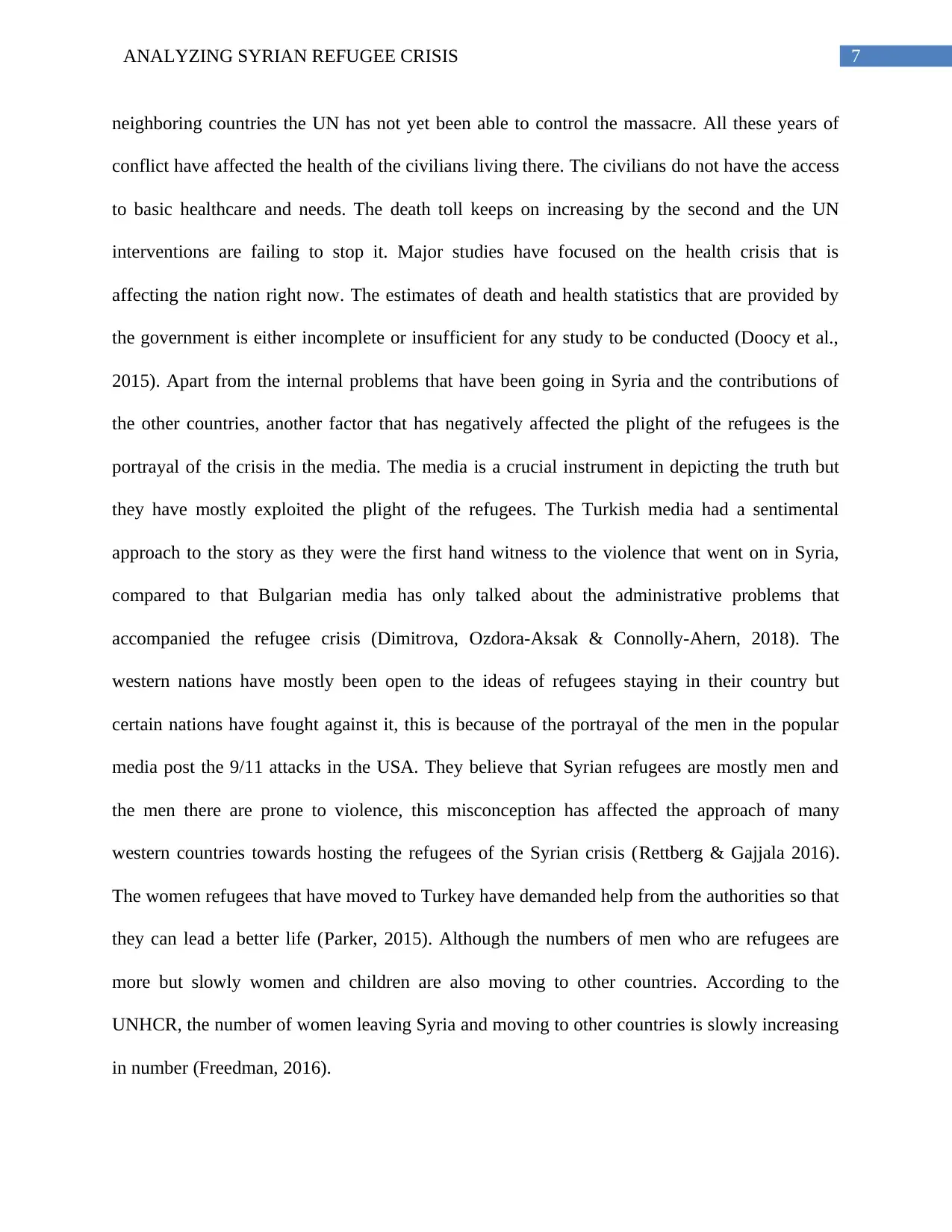
7ANALYZING SYRIAN REFUGEE CRISIS
neighboring countries the UN has not yet been able to control the massacre. All these years of
conflict have affected the health of the civilians living there. The civilians do not have the access
to basic healthcare and needs. The death toll keeps on increasing by the second and the UN
interventions are failing to stop it. Major studies have focused on the health crisis that is
affecting the nation right now. The estimates of death and health statistics that are provided by
the government is either incomplete or insufficient for any study to be conducted (Doocy et al.,
2015). Apart from the internal problems that have been going in Syria and the contributions of
the other countries, another factor that has negatively affected the plight of the refugees is the
portrayal of the crisis in the media. The media is a crucial instrument in depicting the truth but
they have mostly exploited the plight of the refugees. The Turkish media had a sentimental
approach to the story as they were the first hand witness to the violence that went on in Syria,
compared to that Bulgarian media has only talked about the administrative problems that
accompanied the refugee crisis (Dimitrova, Ozdora-Aksak & Connolly-Ahern, 2018). The
western nations have mostly been open to the ideas of refugees staying in their country but
certain nations have fought against it, this is because of the portrayal of the men in the popular
media post the 9/11 attacks in the USA. They believe that Syrian refugees are mostly men and
the men there are prone to violence, this misconception has affected the approach of many
western countries towards hosting the refugees of the Syrian crisis (Rettberg & Gajjala 2016).
The women refugees that have moved to Turkey have demanded help from the authorities so that
they can lead a better life (Parker, 2015). Although the numbers of men who are refugees are
more but slowly women and children are also moving to other countries. According to the
UNHCR, the number of women leaving Syria and moving to other countries is slowly increasing
in number (Freedman, 2016).
neighboring countries the UN has not yet been able to control the massacre. All these years of
conflict have affected the health of the civilians living there. The civilians do not have the access
to basic healthcare and needs. The death toll keeps on increasing by the second and the UN
interventions are failing to stop it. Major studies have focused on the health crisis that is
affecting the nation right now. The estimates of death and health statistics that are provided by
the government is either incomplete or insufficient for any study to be conducted (Doocy et al.,
2015). Apart from the internal problems that have been going in Syria and the contributions of
the other countries, another factor that has negatively affected the plight of the refugees is the
portrayal of the crisis in the media. The media is a crucial instrument in depicting the truth but
they have mostly exploited the plight of the refugees. The Turkish media had a sentimental
approach to the story as they were the first hand witness to the violence that went on in Syria,
compared to that Bulgarian media has only talked about the administrative problems that
accompanied the refugee crisis (Dimitrova, Ozdora-Aksak & Connolly-Ahern, 2018). The
western nations have mostly been open to the ideas of refugees staying in their country but
certain nations have fought against it, this is because of the portrayal of the men in the popular
media post the 9/11 attacks in the USA. They believe that Syrian refugees are mostly men and
the men there are prone to violence, this misconception has affected the approach of many
western countries towards hosting the refugees of the Syrian crisis (Rettberg & Gajjala 2016).
The women refugees that have moved to Turkey have demanded help from the authorities so that
they can lead a better life (Parker, 2015). Although the numbers of men who are refugees are
more but slowly women and children are also moving to other countries. According to the
UNHCR, the number of women leaving Syria and moving to other countries is slowly increasing
in number (Freedman, 2016).

8ANALYZING SYRIAN REFUGEE CRISIS
This essay concludes that the crisis that has been going in Syria for the last few years
has its roots in ethnic and cultural differences. The crisis has majorly affected the human rights
of the people. The refugees have moved to other countries so that they can survive their but
many European countries have turned a blind eye towards them. The neighboring countries of
Syria, Jordan, Lebanon and Turkey have been very welcoming to the outsiders and they have
formed major policies to accommodate the refugees. The men and women staying in Syria are
facing major health crisis, the most vulnerable among are the pregnant women and children who
are facing malnutrition. The image that is portrayed by the media of the refugees does not help
them in anyway, post 9/11 many think that the men from Syria would also be terrorist and this
has led many countries to close their doors towards the refugees. The problem of the crisis is
being dealt with but for Syria to be a safe country to inhabit it will take few more years.
This essay concludes that the crisis that has been going in Syria for the last few years
has its roots in ethnic and cultural differences. The crisis has majorly affected the human rights
of the people. The refugees have moved to other countries so that they can survive their but
many European countries have turned a blind eye towards them. The neighboring countries of
Syria, Jordan, Lebanon and Turkey have been very welcoming to the outsiders and they have
formed major policies to accommodate the refugees. The men and women staying in Syria are
facing major health crisis, the most vulnerable among are the pregnant women and children who
are facing malnutrition. The image that is portrayed by the media of the refugees does not help
them in anyway, post 9/11 many think that the men from Syria would also be terrorist and this
has led many countries to close their doors towards the refugees. The problem of the crisis is
being dealt with but for Syria to be a safe country to inhabit it will take few more years.
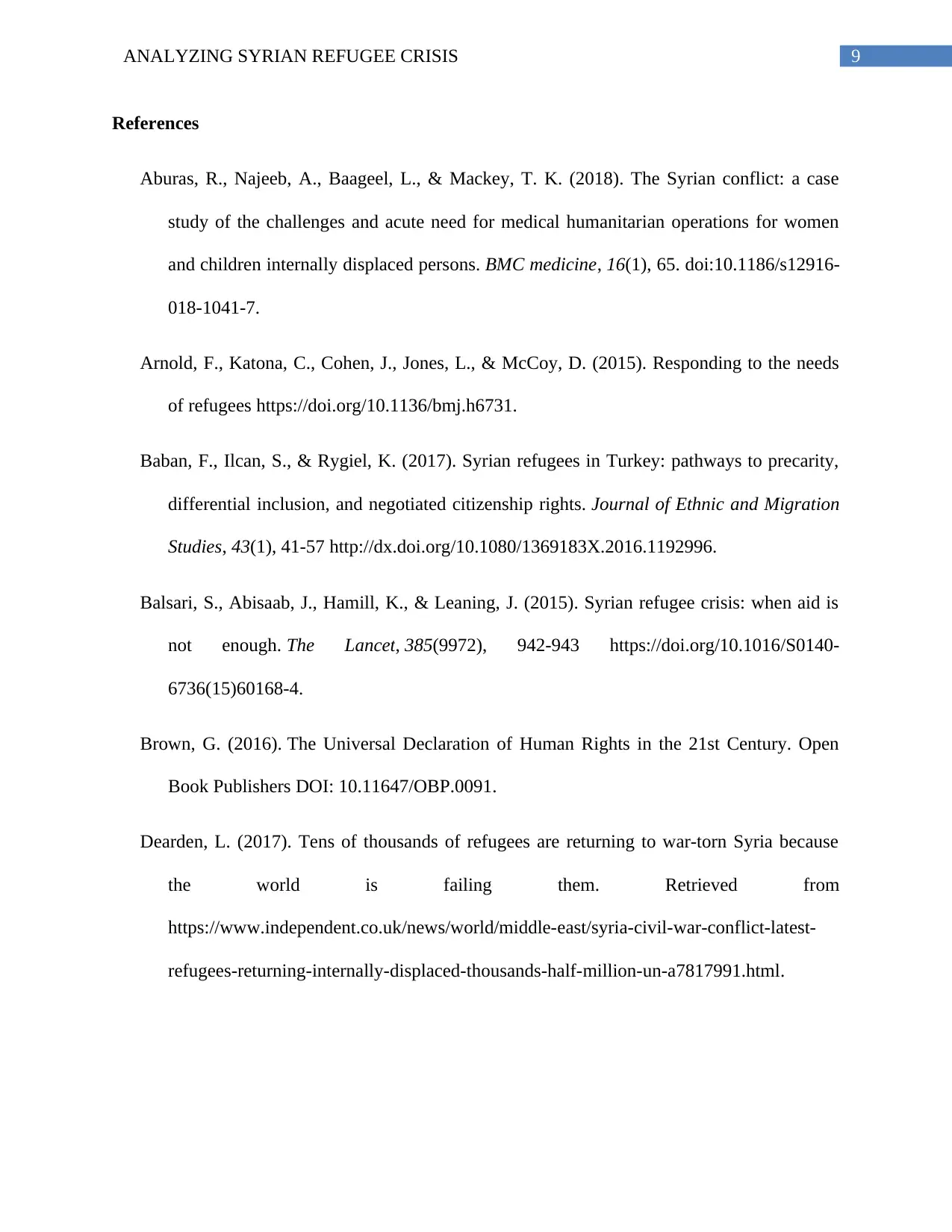
9ANALYZING SYRIAN REFUGEE CRISIS
References
Aburas, R., Najeeb, A., Baageel, L., & Mackey, T. K. (2018). The Syrian conflict: a case
study of the challenges and acute need for medical humanitarian operations for women
and children internally displaced persons. BMC medicine, 16(1), 65. doi:10.1186/s12916-
018-1041-7.
Arnold, F., Katona, C., Cohen, J., Jones, L., & McCoy, D. (2015). Responding to the needs
of refugees https://doi.org/10.1136/bmj.h6731.
Baban, F., Ilcan, S., & Rygiel, K. (2017). Syrian refugees in Turkey: pathways to precarity,
differential inclusion, and negotiated citizenship rights. Journal of Ethnic and Migration
Studies, 43(1), 41-57 http://dx.doi.org/10.1080/1369183X.2016.1192996.
Balsari, S., Abisaab, J., Hamill, K., & Leaning, J. (2015). Syrian refugee crisis: when aid is
not enough. The Lancet, 385(9972), 942-943 https://doi.org/10.1016/S0140-
6736(15)60168-4.
Brown, G. (2016). The Universal Declaration of Human Rights in the 21st Century. Open
Book Publishers DOI: 10.11647/OBP.0091.
Dearden, L. (2017). Tens of thousands of refugees are returning to war-torn Syria because
the world is failing them. Retrieved from
https://www.independent.co.uk/news/world/middle-east/syria-civil-war-conflict-latest-
refugees-returning-internally-displaced-thousands-half-million-un-a7817991.html.
References
Aburas, R., Najeeb, A., Baageel, L., & Mackey, T. K. (2018). The Syrian conflict: a case
study of the challenges and acute need for medical humanitarian operations for women
and children internally displaced persons. BMC medicine, 16(1), 65. doi:10.1186/s12916-
018-1041-7.
Arnold, F., Katona, C., Cohen, J., Jones, L., & McCoy, D. (2015). Responding to the needs
of refugees https://doi.org/10.1136/bmj.h6731.
Baban, F., Ilcan, S., & Rygiel, K. (2017). Syrian refugees in Turkey: pathways to precarity,
differential inclusion, and negotiated citizenship rights. Journal of Ethnic and Migration
Studies, 43(1), 41-57 http://dx.doi.org/10.1080/1369183X.2016.1192996.
Balsari, S., Abisaab, J., Hamill, K., & Leaning, J. (2015). Syrian refugee crisis: when aid is
not enough. The Lancet, 385(9972), 942-943 https://doi.org/10.1016/S0140-
6736(15)60168-4.
Brown, G. (2016). The Universal Declaration of Human Rights in the 21st Century. Open
Book Publishers DOI: 10.11647/OBP.0091.
Dearden, L. (2017). Tens of thousands of refugees are returning to war-torn Syria because
the world is failing them. Retrieved from
https://www.independent.co.uk/news/world/middle-east/syria-civil-war-conflict-latest-
refugees-returning-internally-displaced-thousands-half-million-un-a7817991.html.
Secure Best Marks with AI Grader
Need help grading? Try our AI Grader for instant feedback on your assignments.

10ANALYZING SYRIAN REFUGEE CRISIS
Devakumar, D., Birch, M., Rubenstein, L. S., Osrin, D., Sondorp, E., & Wells, J. C. (2015).
Child health in Syria: recognising the lasting effects of warfare on health. Conflict and
health, 9(1), 34 https://doi.org/10.1186/s13031-015-0061-6.
Dimitrova, D., Ozdora-Aksak, E., & Connolly-Ahern, C. (2018). On the Border of the Syrian
Refugee Crisis: Views From Two Different Cultural Perspectives [Ebook]. Sage
Publishers DOI: 10.1177/0002764218756920.
Doocy, S., Lyles, E., Delbiso, T. D., & Robinson, C. W. (2015). Internal displacement and
the Syrian crisis: an analysis of trends from 2011–2014. Conflict and health, 9(1), 33
https://doi.org/10.1186/s13031-015-0060-7.
Freedman, J. (2016). Sexual and gender-based violence against refugee women: a hidden
aspect of the refugee" crisis". Reproductive health matters, 24(47), 18-26
https://doi.org/10.1016/j.rhm.2016.05.003.
Kneebone, S. (Ed.). (2018). The Refugees Convention 50 Years on: Globalisation and
International Law: Globalisation and International Law. Routledge.
Newsome, A. (2019). Credible champions? Transatlantic relations and human rights in
refugee crises [Ebook]. Routledge Taylor and Francis Group
https://doi.org/10.1080/07036337.2018.1487964.
Parker, S. (2015). Hidden crisis: violence against Syrian female refugees. The
Lancet, 385(9985), 2341-2342 https://doi.org/10.1016/S0140-6736 (15)61091-1.
Peters, M. A., & Besley, T. (2015). The refugee crisis and the right to political asylum
https://www.tandfonline.com/doi/full/10.1080/00131857.2015.1100903.
Devakumar, D., Birch, M., Rubenstein, L. S., Osrin, D., Sondorp, E., & Wells, J. C. (2015).
Child health in Syria: recognising the lasting effects of warfare on health. Conflict and
health, 9(1), 34 https://doi.org/10.1186/s13031-015-0061-6.
Dimitrova, D., Ozdora-Aksak, E., & Connolly-Ahern, C. (2018). On the Border of the Syrian
Refugee Crisis: Views From Two Different Cultural Perspectives [Ebook]. Sage
Publishers DOI: 10.1177/0002764218756920.
Doocy, S., Lyles, E., Delbiso, T. D., & Robinson, C. W. (2015). Internal displacement and
the Syrian crisis: an analysis of trends from 2011–2014. Conflict and health, 9(1), 33
https://doi.org/10.1186/s13031-015-0060-7.
Freedman, J. (2016). Sexual and gender-based violence against refugee women: a hidden
aspect of the refugee" crisis". Reproductive health matters, 24(47), 18-26
https://doi.org/10.1016/j.rhm.2016.05.003.
Kneebone, S. (Ed.). (2018). The Refugees Convention 50 Years on: Globalisation and
International Law: Globalisation and International Law. Routledge.
Newsome, A. (2019). Credible champions? Transatlantic relations and human rights in
refugee crises [Ebook]. Routledge Taylor and Francis Group
https://doi.org/10.1080/07036337.2018.1487964.
Parker, S. (2015). Hidden crisis: violence against Syrian female refugees. The
Lancet, 385(9985), 2341-2342 https://doi.org/10.1016/S0140-6736 (15)61091-1.
Peters, M. A., & Besley, T. (2015). The refugee crisis and the right to political asylum
https://www.tandfonline.com/doi/full/10.1080/00131857.2015.1100903.
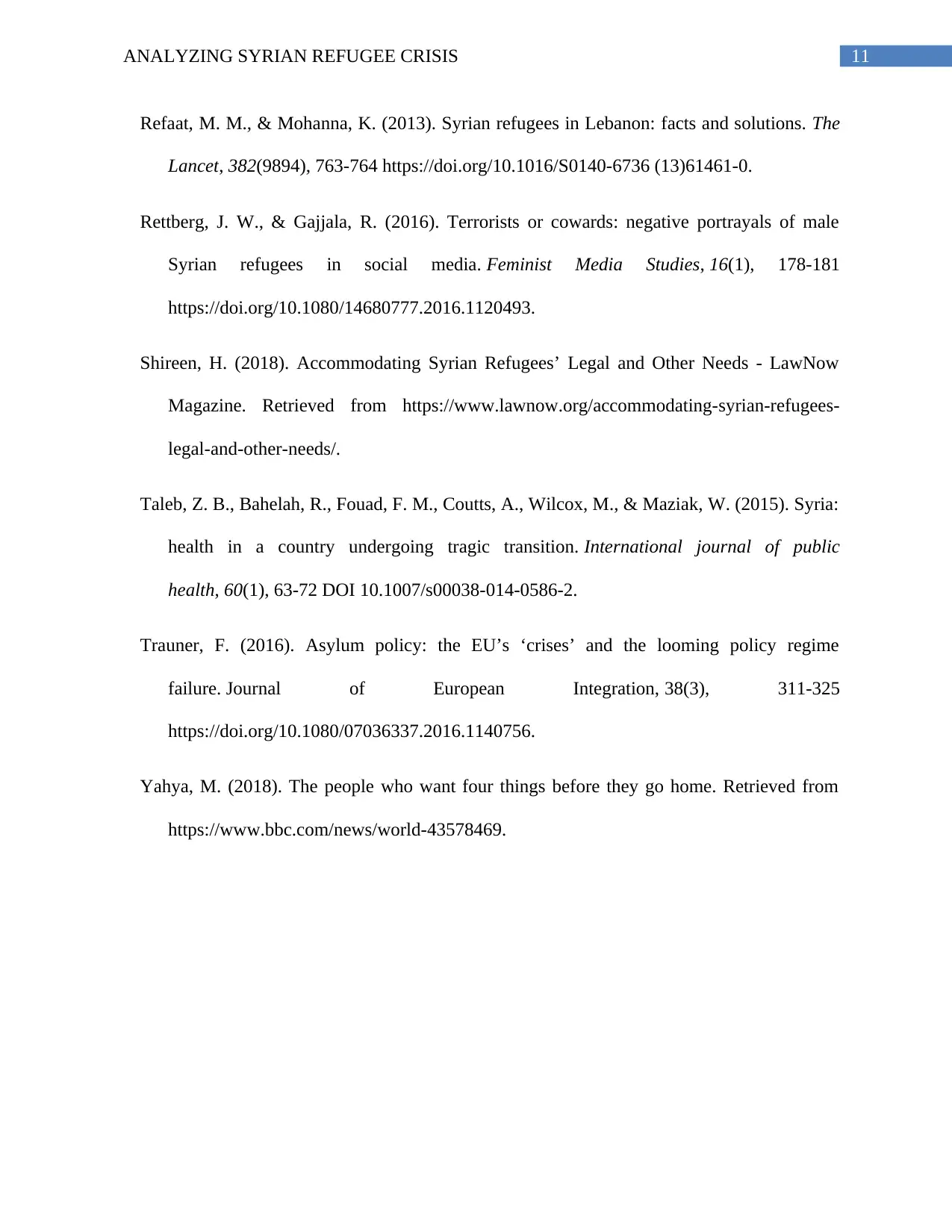
11ANALYZING SYRIAN REFUGEE CRISIS
Refaat, M. M., & Mohanna, K. (2013). Syrian refugees in Lebanon: facts and solutions. The
Lancet, 382(9894), 763-764 https://doi.org/10.1016/S0140-6736 (13)61461-0.
Rettberg, J. W., & Gajjala, R. (2016). Terrorists or cowards: negative portrayals of male
Syrian refugees in social media. Feminist Media Studies, 16(1), 178-181
https://doi.org/10.1080/14680777.2016.1120493.
Shireen, H. (2018). Accommodating Syrian Refugees’ Legal and Other Needs - LawNow
Magazine. Retrieved from https://www.lawnow.org/accommodating-syrian-refugees-
legal-and-other-needs/.
Taleb, Z. B., Bahelah, R., Fouad, F. M., Coutts, A., Wilcox, M., & Maziak, W. (2015). Syria:
health in a country undergoing tragic transition. International journal of public
health, 60(1), 63-72 DOI 10.1007/s00038-014-0586-2.
Trauner, F. (2016). Asylum policy: the EU’s ‘crises’ and the looming policy regime
failure. Journal of European Integration, 38(3), 311-325
https://doi.org/10.1080/07036337.2016.1140756.
Yahya, M. (2018). The people who want four things before they go home. Retrieved from
https://www.bbc.com/news/world-43578469.
Refaat, M. M., & Mohanna, K. (2013). Syrian refugees in Lebanon: facts and solutions. The
Lancet, 382(9894), 763-764 https://doi.org/10.1016/S0140-6736 (13)61461-0.
Rettberg, J. W., & Gajjala, R. (2016). Terrorists or cowards: negative portrayals of male
Syrian refugees in social media. Feminist Media Studies, 16(1), 178-181
https://doi.org/10.1080/14680777.2016.1120493.
Shireen, H. (2018). Accommodating Syrian Refugees’ Legal and Other Needs - LawNow
Magazine. Retrieved from https://www.lawnow.org/accommodating-syrian-refugees-
legal-and-other-needs/.
Taleb, Z. B., Bahelah, R., Fouad, F. M., Coutts, A., Wilcox, M., & Maziak, W. (2015). Syria:
health in a country undergoing tragic transition. International journal of public
health, 60(1), 63-72 DOI 10.1007/s00038-014-0586-2.
Trauner, F. (2016). Asylum policy: the EU’s ‘crises’ and the looming policy regime
failure. Journal of European Integration, 38(3), 311-325
https://doi.org/10.1080/07036337.2016.1140756.
Yahya, M. (2018). The people who want four things before they go home. Retrieved from
https://www.bbc.com/news/world-43578469.
1 out of 12
Related Documents
Your All-in-One AI-Powered Toolkit for Academic Success.
+13062052269
info@desklib.com
Available 24*7 on WhatsApp / Email
![[object Object]](/_next/static/media/star-bottom.7253800d.svg)
Unlock your academic potential
© 2024 | Zucol Services PVT LTD | All rights reserved.





